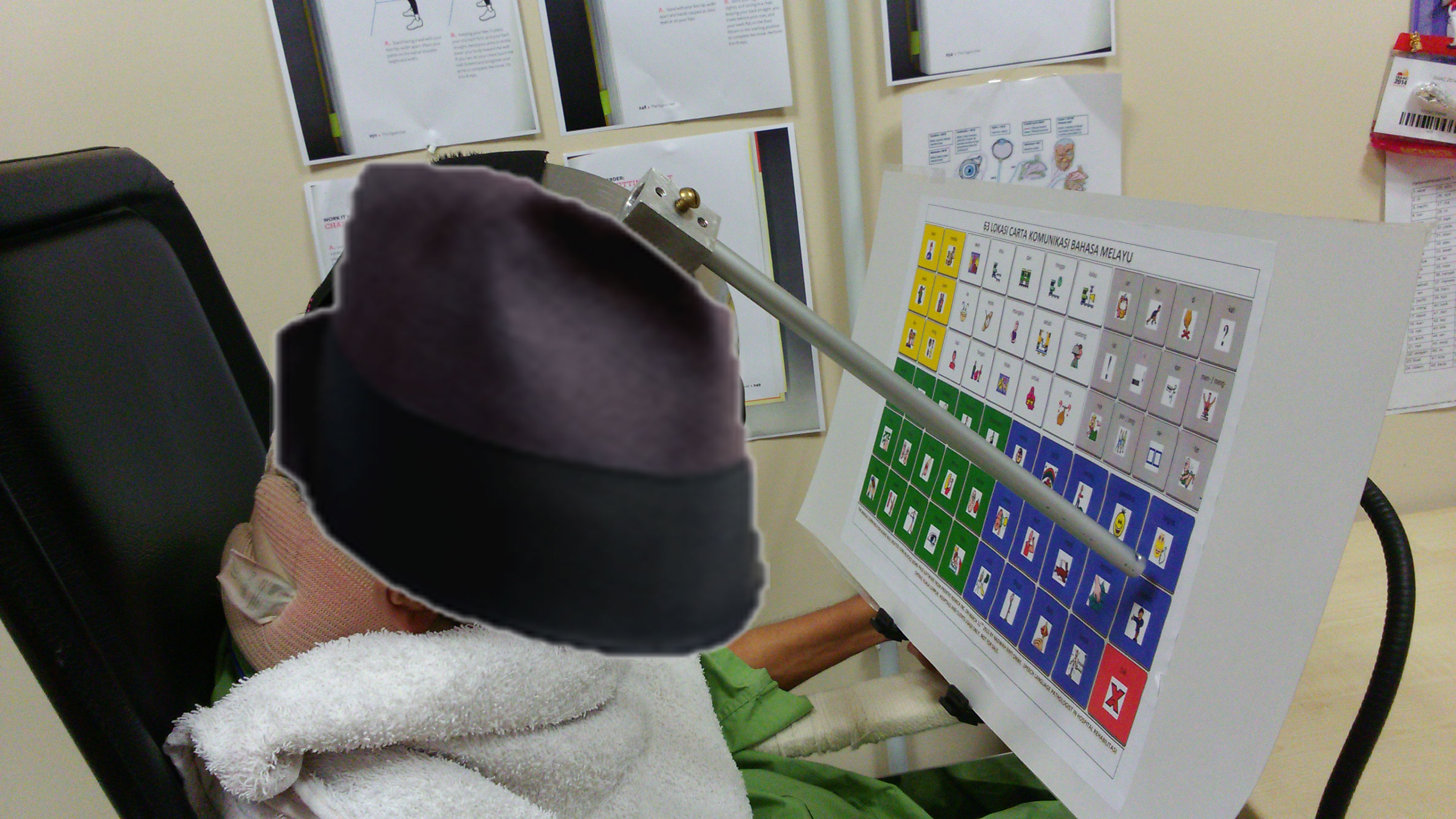A manual communication board is a board with pictures or symbols with written words. A manual board is use by an individual to select words to create messages during communication. The characteristics of a manual communication board are:
- Core vocabulary arranged within different paper size systematically following color-coding system.
- Consist of single meaning pictures or pictures with pre-stored messages.
- Additional or replacement to residual speech skills.
- Created using multiple symbols or pictures following different sizes and shapes, easy to read and labeled following part-of-speech (e.g. pronouns, verbs, adjectives and adverbs).
- For pointing can be done using head pointer or any body part that move (e.g. toes) to build meaningful sentences during communication.

Head pointer may be utilized to point words on the manual communication board.
Intended Users of A Manual Communication Board
- It is suitable for children and adult with complex communication needs who had severe speech and language disorder.
- A manual communication board is use to share idea, stories, experience, and exchanging thoughts between communication partners.
- Many reasons may lead to failure in developing oral speech. The etiologies are cerebral palsy, traumatic brain injury, autism, Down Syndrome, global developmental delay or stroke, amyotrophic lateral sclerosis (ALS) and “locked-in” syndrome.

Communication Board can be used to practice organization during cooking for individual with low cognitive skills
Improve Language and Communication Skills
-
A manual communication board is suitable to enhance communication skills in helping a person to live a meaningful life, minimize depression and psychosocial stress.
-
It can also help individual to regain functional communication within their social groups.
-
Person using AAC may experience equality in gaining vocational and leisure activity through effective communication.
-
A research in the United Kingdom (2013) showed a prevalence of individual who benefit from AAC achieved 0.5 percent from population (Resource: Communication Matters, 2013).
7 Tips: Communicating with Individual with Complex Communication Need
(Resource: The RERC on Communication Enhancement. Visit www.rerc-aac.psu.edu.)
Identify the basic communication technique by asking these questions:
- How do you say “YES”
- How do you say “NO”
- Show me how do you point to an object or individual when you need something.
- Ask one question at a time clearly and easy to answer.
- Give extra time to answer the question.
- Take time to understand clearly.
- You can provide three sentences such as “I don’t know”, “Please Repeat” and “I don’t understand”.
Access System for Manual Communication System
- A person with quadriplegic condition may face difficulty in accessing or pointing to a manual communication board due to poor limbs movement. The access system shown below may be recommended for them for pointing.

Your FIRST Manual Communication Board in Malay : Make Your Right Decision!
Download your FIRST manual communication in Malay for FREE!
You can download FREE PASS DEMO Software of NuVoice here to create your own manual communication board!
- PASS Demo Software can be used to create manual communication board easily
Effects of Ineffective Communication
Failure to receive early intervention of AAC may limit individual’s ability to communicate that at the end stops them from returning to work, and can lead to depression. If a person continue to have very limited communication abilities, individual may develop suicidal ideation, hurting others or potraying an aggressive behavior.
Do You Need Help with AAC?
Contact Nadwah Onwi (nadwahonwi@moh.gov.my) or speech language therapist around you to know more about AAC and how AAC can help you or your family to improve their complex communication needs.
References
- Communication Matters, United Kingdom, 2013
- Prentke Romich Company Website. Retrieved from https://www.prentrom.com/downloads/pass?id=205 on September, 10, 2015.
- The RERC on Communication Enhancement. Retrieved from rerc-aac.psu.edu on September, 10, 2015.
| Last Reviewed | : | 28 August 2020 |
| Writer / Translator | : | Nadwah bt. Onwi |
| Accreditor | : | Zaidi bin Ya’acob |
| Reviewer | : | Nadwah bt. Onwi |









